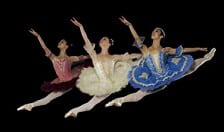Nonprofit: Ballet Des Moines
Ballet Des Moines kicked off the 2012-2013 season with something it didn't have last year: its own dancers

With the conclusion of “Prelude: A Triple Bill” last weekend, Ballet Des Moines reached a significant milestone: its first performance with professional dancers of its own.
Until September, the nonprofit arts organization, which has been around since 2002, hired dancers from larger theaters across the country, said Executive Director Rachel Gross. Ballet Des Moines would fly in the dancers, who would stay in the city long enough to learn choreography and perform before heading back home to places like Chicago or Tulsa.
With support from the community, Ballet Des Moines was able to recruit and hire six professional dancers from across the country to perform in its 26-week season.
And though the Civic Center of Greater Des Moines brings in dance troupes from around the world and there are several community-based ballet schools in the area, Ballet Des Moines is the primary ballet company in the region, which is one reason Gross believes the professional dancers are so important.
“Des Moines is an up-and-coming city, and we want to help expand the cultural landscape here,” she said, adding that it’s vital for all major cities to have a ballet, opera and theater.
Gross credited Artistic Director Serkan Usta for Ballet Des Moines’ success and said he is a “driving force” behind the organization.
This season, Ballet Des Moines will put on three major performances. In addition to last weekend’s show, the dancers will perform “The Nutcracker” during the holiday season and “Snow White” on March 30.
It also offers educational outreach programs to train Des Moines’ next generation of dancers, giving them opportunities to perform in “The Nutcracker” and through Ballet Des Moines II.
Gross said the organization’s six new dancers give Ballet Des Moines II dancers, who range in age from 13 to 18 years old, new opportunities to learn. That increases the likelihood of the young dancers staying in Des Moines when they’re older.
“They’re now able to stay in Des Moines and don’t have to move to keep dancing,” she said.











